Articles
- Page Path
- HOME > J Korean Acad Nurs > Volume 42(7); 2012 > Article
-
Original Article
- Development and Evaluation of a Video Discharge Education Program focusing on Mother-infant Interaction for Mothers of Premature Infants
- Jin Suk Ra, Jiyoung Lim
-
Journal of Korean Academy of Nursing 2012;42(7):936-946.
DOI: https://doi.org/10.4040/jkan.2012.42.7.936
Published online: December 31, 2012
1College of Nursing, Chungnam National University, Daejeon, Korea.
2College of Nursing, CHA University, Gyeonggi, Korea.
- Address reprint requests to: Lim, Jiyoung. College of Nursing, CHA University, 222 Yatap-dong, Sungnam, Gyeonggi-do 463-836, Korea. Tel: 82-31-725-8320, Fax: 82-31-725-8329, limjy62@cha.ac.kr
• Received: June 11, 2012 • Revised: July 10, 2012 • Accepted: November 13, 2012
© 2012 Korean Society of Nursing Science
- 1,527 Views
- 3 Download
- 15 Crossref
Abstract
-
Purpose
- This study was done to develop a video discharge education program focusing on mother-infant interaction to facilitate the development of maternal role confidence for mothers of premature infants.
-
Methods
- The process of the program was based on the Network-based Instructional System Design suggested by Jung (1999). For the content of the program, needs and concerns of mothers of premature infants found on web sites and existing literature were analyzed. Based on this content, the scenario and the video were developed. Nurses and mothers of premature infants participated in the process of testing the content validity, scenario development, and evaluation of final video production. The final video has two parts and lasts 21 minutes. The first part focuses on mother-premature infant interaction and the second part focuses on health management of infants.
-
Results
- Eleven mothers of premature infants participated in the evaluation of the appropriateness of the video as a teaching method and for educational content. They reported that the content on mother-infant interaction, maternal sensitivity, and maternal role confidence was especially beneficial.
-
Conclusion
- The findings indicate that video program is effective for education on maternal-premature infant interaction and the use of video in practical settings is strongly recommended.
INTRODUCTION
METHODS
1) Analysis
(1) Content analysis of parental concerns of premature infants
(2) Content analysis of the existing discharge education programs
(3) Technique and environment analysis
2) Design
3) Development
(1) Development of themes for the program
(2) Development of content for the program
(3) Development of the scenario
(4) Video production
4) Operation
1) Appropriateness of teaching method and content of the program
2) Quality of video
3) The self-evaluation program effects on improvement of mother-infant interaction
4) The effects of the self-evaluation program on improvement in maternal sensitivity
5) The effects of the self-evaluation program on improvement in maternal role confidence
RESULTS
1) Appropriateness of teaching method and content of the program
2) Quality of video
3) The effects of the program
DISCUSSION
CONCLUSION
This article is a condensed form of the first author's doctoral dissertation from Yonsei University.
- 1. Browne JV, Talmi A. Family-based intervention to enhance infant-parent relationships in the neonatal intensive care unit. J Pediatr Psychol. 2005;30:667–677. http://dx.doi.org/10.1093/jpepsy/jsi053.ArticlePubMed
- 2. Cho KJ, Jung Y, Lee KJ. The educational needs of the mothers of LBW infants and normal neonate. Korean J Child Health Nurs. 1997;3(1):5–18.
- 3. Choi SJ, Kwon MK. A comparative study on education needs in low birth weight infant's mother at discharge and after one month at home. Korean Parent Child Health J. 2000;3(1):73–94.
- 4. Gagliano ME. A literature review on the efficacy of video in patient education. J Med Educ. 1988;63:785–792.ArticlePubMed
- 5. Gimeno-García AZ, Quinetro E, Nicolás-Pérez D, Parra-Blanco A, Jiménez-Sosa A. Impact of an educational video-based strategy on the behavior process associated with colorectal cancer screening: A randomized controlled study. Cancer Epidemiol. 2009;33:216–222. http://dx.doi.org/10.1016/j.canep.2009.08.003.ArticlePubMed
- 6. Han KE. The relationship of maternal self-esteem and maternal sensitivity with mother-to-infant attachment. 2002;Seoul, Hanyang University. Unpublished master's thesis.
- 7. Hwang SJ. The effect of infant massage on body weight, height, and mother-infant interaction of infants. 2003;Chuncheon, Kangwon National University. Unpublished master's thesis.
- 8. Jackson K, Temestedt BM, Schollin J. From alienation to familiarity: Experiences of mothers and fathers of preterm infants. J Adv Nurs. 2003;43(2):120–129. http://dx.doi.org/10.1046/j.1365-2648.2003.02686.x.ArticlePubMedPDF
- 9. Jang YS. Effects of work book program on perceived stress level, maternal role confidence and breast feeding practice of mothers of premature infants. J Korean Acad Nurs. 2005;35(2):419–427.ArticlePDF
- 10. Jeong HJ. Development and effectiveness of hemodialysis nursing education program using web-based learning system. Korean J Nurs Query. 2000;9:144–166.
- 11. Johnson AN. Promoting maternal confidence in the NICU. J Pediatr Health Care. 2008;22:254–257. http://dx.doi.org/10.1016/j.pedhc.2007.12.012.ArticlePubMed
- 12. Jung IS. Understanding of distance education. 1999;Seoul, Koyyuk Science Company.
- 13. Kärtner J, Keller H, Yovsi RD. Mother-infant interaction during the first 3 months: The emergence of culture-specific contingency patterns. Child Dev. 2010;81:540–554. http://dx.doi.org/10.1111/j.1467-8624.2009.01414.x.ArticlePubMed
- 14. Kolb D. Experiential learning: Experiences as the source of learning and development. 1984;Englewood Cliffs, NJ, Prentice-Hall, Inc.
- 15. Krouse HJ. Video modeling to educate patients. J Adv Nurs. 2001;33:748–757. http://dx.doi.org/10.1046/j.1365-2648.2001.01716.x.PubMed
- 16. Kwon HK, Kwon MK. Effects of discharge education program for mothers of premature infants on maternal role confidence and parenting stress. J Korean Acad Child Health Nurs. 2007;13(1):58–65.
- 17. Lagner SM. Preparing a family for home monitoring. Neonatal Netw. 1988;6:57–60.PubMed
- 18. Landry SH, Smith KE, Swank PR. Responsive parenting: Establishing early foundations for social, communication, and independent problem-solving skills. Dev Psychol. 2006;42(4):627–642. http://dx.doi.org/10.1037/0012-1649.42.4.627.ArticlePubMed
- 19. Lederman RP, Weingarten CG, Lederman E. Post partum self-evaluation questionnaire: Measure of maternal adaption. Birth Defects Orig Artic Ser. 1981;17(6):201–231.
- 20. Lee JM, Oh SJ, Kim JA, Lee EJ, Lee JY, Hwang MS, et al. Effects a home-based discharge program for mothers of premature infants on oxygen therapy at home. J Korean Acad Child Health Nurs. 2010;16(2):144–155. http://dx.doi.org/10.4094/jkachn.2010.16.2.144.Article
- 21. Lee NY, Kim YH. Development and evaluation of an e-learning program for mothers of premature infants. J Korean Acad Nurs. 2008;38(1):152–160. http://dx.doi.org/10.4040/jkan.2008.38.1.152.Article
- 22. Lee YE. An experimental study on the impact of an agreement on the means to achieve nursing goals in the early postpartum period of primiparous mother and enhance their self-confidence and satisfaction in maternal role performance. J Nurs Acad Soc. 1992;22(1):81–115.ArticlePDF
- 23. Maquire CM, Bruil J, Wit JM, Walther FJ. Reading preterm infants' behavioral cues: An intervention study with parents of premature infants born < 32 weeks. Early Hum Dev. 2007;83:419–424. http://dx.doi.org/10.1016/j.earlhumdev.2007.03.004.ArticlePubMed
- 24. Melynk BM, Feinstein NF, Alpert-Gillis L, Fairbanks E, Crean HF, Sinkin RA, et al. Reducing premature infants' length of stay and improving parents' mental health outcomes with the Creating Opportunities for Parent Empowerment (COPE) Neonatal Intensive Careunit program: A randomized, controlled trial. Pediatrics. 2006;118:e1414–e1427. http://dx.doi.org/10.1542/peds.2005-2580.ArticlePubMedPDF
- 25. Mercer RT. Becoming a mother: Research on maternal identity from Rubin to the present. 1995;New York, Springer.
- 26. Park HJ. Development of educational video program on women's urinary incontinence: Pelvic floor music exercise. 2001;Seoul, Ewha Womans University. Unpublished master's thesis.
- 27. Scherf RF, Reid KW. Going home: What NICU nurses need to know about home care. Neonatal Netw. 2006;25:421–425. http://dx.doi.org/10.1891/0730-0832.25.6.421.ArticlePubMed
- 28. Shin SM, Lee IH. Caring for healthy little my baby: Guide for caring of premature infants. 2003;Seoul, Arisk.
- 29. Song AS, Park IH, Joo AR. Effects of supportive care using the telephone for mothers of premature infants on anxiety and confidence of baby care after discharge. J Korean Soc Matern Child Health. 2007;11(1):98–108.Article
REFERENCES
Figure & Data
REFERENCES
Citations
Citations to this article as recorded by 

- Neonatal intensive care unit discharge education interventions and their effects on maternal sensitivity and neurocognitive development of premature infants: a protocol for a systematic review
Laidi Sulemani Msisiri, Nahya Salim Masoud, Golden Mwakibo Masika, Elizabeth Francis Msoka
Systematic Reviews.2025;[Epub] CrossRef - Child development education in the Neonatal Unit: Understanding parent developmental literacy needs, priorities and preferences
Megan L. Bater, Jacqueline F. Gould, Carmel T. Collins, Peter J. Anderson, Michael J. Stark
Patient Education and Counseling.2024; 119: 108058. CrossRef - Pengaruh Edukasi Audiovisual terhadap Pengetahuan, Keterampilan dan Efikasi Ibu dalam Melakukan Perawatan Metode Kanguru (PMK)
Sholihatul Amaliya, Jelita Maharanie, Lucy Puspita Septiana, Nabiela Kamalia, Rahma Putri Utami, Laily Yuliatun, Asti Melani Astari, Rinik Eko Kapti, Nurona Azizah
Health Information : Jurnal Penelitian.2024; 16(3): e1243. CrossRef - The Effect of a Virtual Educational and Supportive Intervention on the Mothers’ Resilience with Preterm Infants: A Quasi-experimental Study
Zohreh Khoshnood, Monirsadat Nematollahi, Elnaz Monemi
Middle East Journal of Rehabilitation and Health Studies.2023;[Epub] CrossRef - Effects of maternal voice on pain and mother–Infant bonding in premature infants in Taiwan: A randomized controlled trial
Wan-Chen Yu, Ming-Chou Chiang, Kuan-Chia Lin, Chun-Chu Chang, Kai-Hui Lin, Chi-Wen Chen
Journal of Pediatric Nursing.2022; 63: e136. CrossRef - Using a Global Health Media Project Video to Increase Knowledge and Confidence in the Mothers of Admitted Neonates in Rwanda: A Prospective Interventional Study
Richard Arinitwe, Alice Willson, Sean Batenhorst, Peter T Cartledge
Journal of Tropical Pediatrics.2020; 66(2): 136. CrossRef - Effect of Interpersonal Psychotherapy Oriented Child Birth Education on Stress and Role Adaption in Mothers with Premature Birth: A Randomized Clinical Trial
Fereshteh Pouyan, Mahnaz Akbari Kamrani, Mitra Rahimzadeh, Mansoreh Jamshidimanesh, Sara Esmaelzadeh–Saeieh
Iranian Journal of Psychiatry and Behavioral Sciences.2019;[Epub] CrossRef - Nutrition education and cooking workshops for families of children with cancer: a feasibility study
S. Beaulieu-Gagnon, V. Bélanger, C. Meloche, D. Curnier, S. Sultan, C. Laverdière, D. Sinnett, V. Marcil
BMC Nutrition.2019;[Epub] CrossRef - Implementing a Parent Education Program in the Special Care Nursery
La Monica L. Hunter, Stephanie Blake, Catherine Simmons, Julie Thompson, Anne Derouin
Journal of Pediatric Health Care.2019; 33(2): 131. CrossRef - A Smart Phone Application for the Mothers of Premature Infants
A. Nourani, H. Ayatollahi, K. Mirnia
IRBM.2019; 40(5): 263. CrossRef - eHealth interventions for parents in neonatal intensive care units: a systematic review protocol
Justine Dol, Alannah Delahunty-Pike, Sheren Anwar Siani, Marsha Campbell-Yeo
JBI Database of Systematic Reviews and Implementation Reports.2017; 15(7): 1835. CrossRef - eHealth interventions for parents in neonatal intensive care units: a systematic review
Justine Dol, Alannah Delahunty-Pike, Sheren Anwar Siani, Marsha Campbell-Yeo
JBI Database of Systematic Reviews and Implementation Reports.2017; 15(12): 2981. CrossRef - Understanding Effective Delivery of Patient and Family Education in Pediatric Oncology: A Systematic Review From the Children’s Oncology Group
Cheryl C. Rodgers, Catherine M. Laing, Ruth Anne Herring, Nancy Tena, Adrianne Leonardelli, Marilyn Hockenberry, Verna Hendricks-Ferguson
Journal of Pediatric Oncology Nursing.2016; 33(6): 432. CrossRef - The Effect of Health Education Video on Ocular Massage After Trabeculectomy
LIU HUA, LV YINGJUAN, ZHAO JINGSHU, CAO WEI
CIN: Computers, Informatics, Nursing.2014; 32(6): 294. CrossRef - The effect of a web‐based education programme (WBEP) on disease severity, quality of life and mothers' self‐efficacy in children with atopic dermatitis
Hae Kyoung Son, Jiyoung Lim
Journal of Advanced Nursing.2014; 70(10): 2326. CrossRef
- Figure
- We recommend
- Related articles
-
- Development and Evaluation of Motivational Interviewing Pulmonary Rehabilitation Program Based on Self-Determination Theory for Patients with Chronic Obstructive Pulmonary Disease
- Development and Evaluation of an App-Based Self-Management Program for Exercise Practice of Breast Cancer Survivors: A Non-Randomized Controlled Trial
Development and Evaluation of a Video Discharge Education Program focusing on Mother-infant Interaction for Mothers of Premature Infants
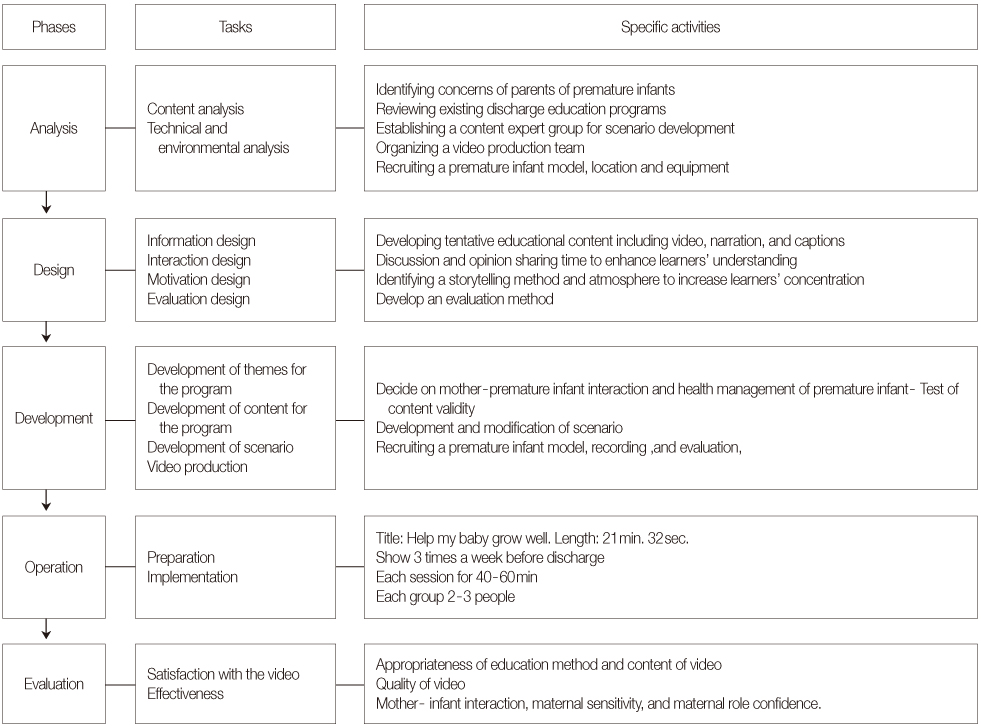
Figure 1
Program development process.
Figure 1
Development and Evaluation of a Video Discharge Education Program focusing on Mother-infant Interaction for Mothers of Premature Infants
Content of Questions from the Parents of Premature Infants on the Internet (N=263)
Content Validity of the Program (N=30)
General Characteristics of Participants in Program Evaluation (N=11)
Evaluation of Appropriateness and Effects of the Program (N=11)
Table 1
Content of Questions from the Parents of Premature Infants on the Internet (N=263)
Table 2
Content Validity of the Program (N=30)
Table 3
General Characteristics of Participants in Program Evaluation (N=11)
Table 4
Evaluation of Appropriateness and Effects of the Program (N=11)
 KSNS
KSNS
 E-SUBMISSION
E-SUBMISSION

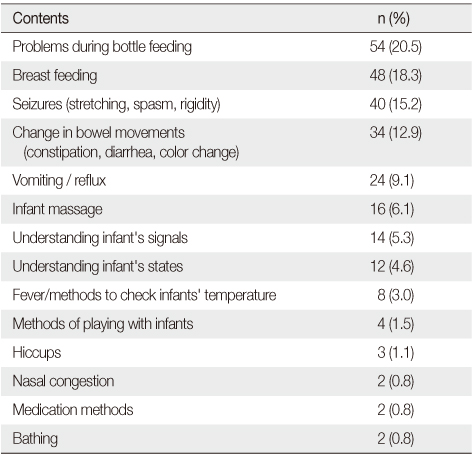
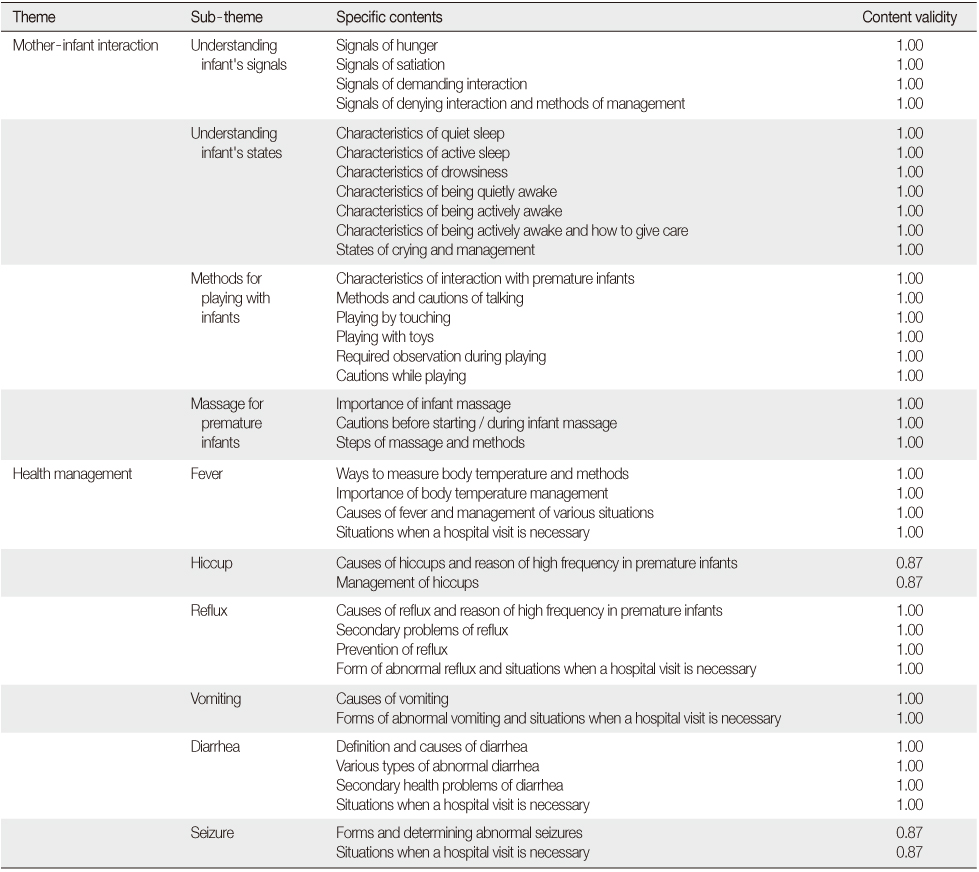
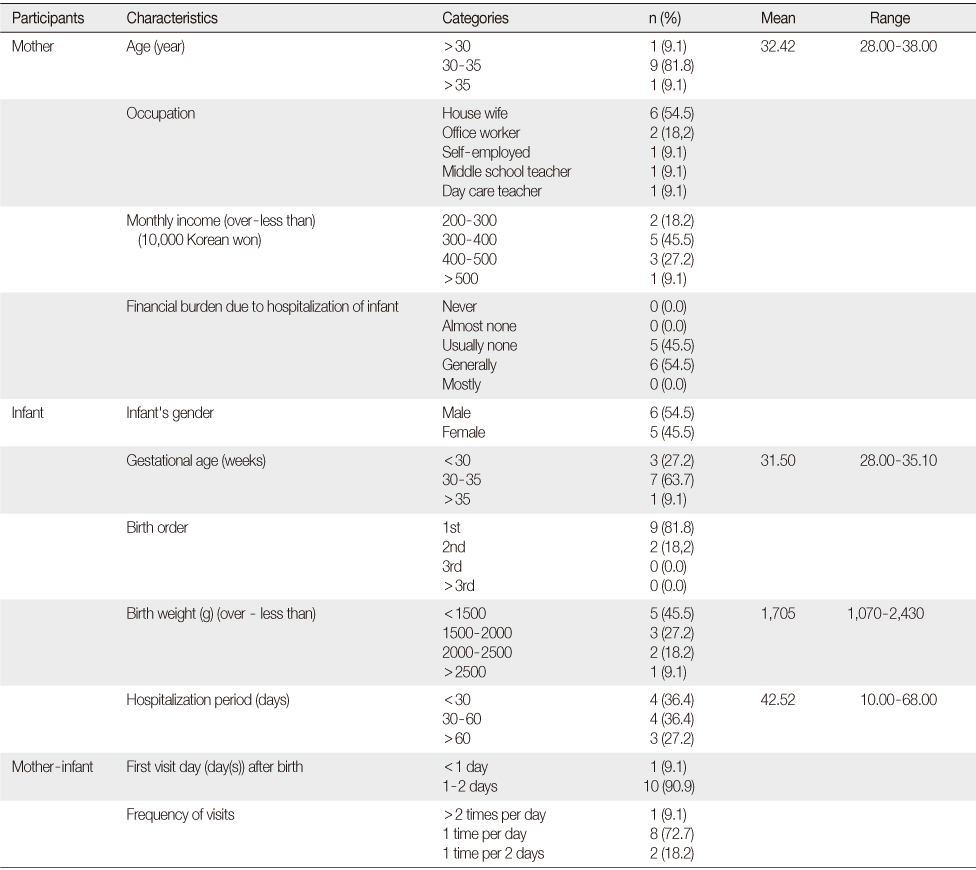
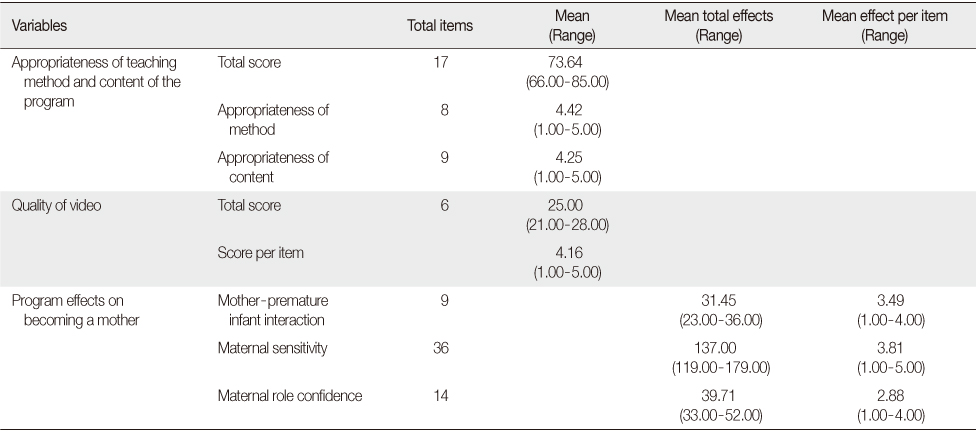
 Cite
Cite

